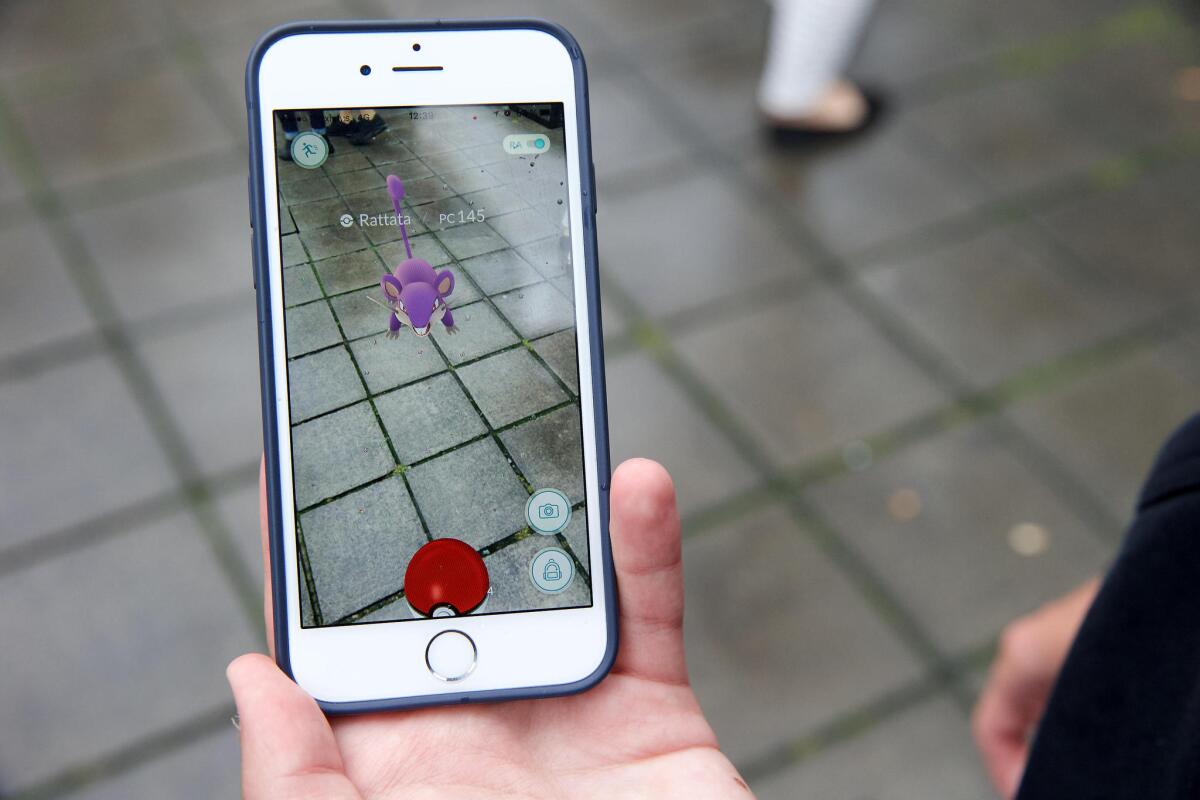‘Pokemon Go’ maker dreams of video games played on contact lenses

- Share via
If John Hanke, chief executive of “Pokemon Go” creator Niantic Labs, had his way, gamers would wear Internet-connected contact lenses, spend big at businesses promoted in his games and clean up neighborhood parks.
Hanke has become an overnight rock star in the tech industry through the instant popularity of the Pokemon mobile game, the fastest app ever to reach 50 million downloads. But that huge audience, now nearing 100 million downloads, has also blasted criticism at the young company — users are exasperated over missing features, frustrating strategic decisions and a lack of availability in much of the world.
Niantic (pronounced nigh-an-tic) has said its more than 50 employees have worked into nights addressing issues. But for all the backlash, Hanke is upbeat. The game is achieving its mission and moving toward his vision of the future, he noted during an onstage conversation with The Times at VentureBeat’s GamesBeat conference Tuesday in Rancho Palos Verdes.
See the most-read stories this hour »
“It seems to be working,” he said.
“Pokemon Go” is a fully re-engineered take on “Ingress,” a mobile game Hanke and a small team developed at Google after he spent six years as a high-level leader at the tech giant’s mapping division.
Though “Ingress” was a cult hit, Niantic thought attaching something from pop culture to the game would attract a bigger audience. Hanke sought out Pokemon, having seen his three children fill the house over the years with trading cards, guidebooks and video games tied to the animated franchise.
The fact that executives on the other side were hardcore “Ingress” players sealed the deal.
“The proof point with “Ingress” to show what they were capable of makes those decision easier,” said J.C. Smith, senior director of consumer marketing at Pokémon Co. International. “There wasn’t another game out there like that.”

The relationship solidified as Niantic separated from Google and became a standalone company last year, allowing Pokemon Co. and Pokemon game developer Nintendo to become shareholders alongside Google. Hanke turned down some venture capitalists, making the new partners feel ever more comfortable that their “crown jewel property” would be protected, he said.
The games share goals: Get people to move around. Get them to see the world with new eyes, discovering the lore and secrets of their city. Gently encourage exercise, something near to Hanke as a parent watching his kids stare at screens all day. Complement in-app purchases with another revenue stream. And help people connect offline.
Forging ahead in the games requires walking around and stopping at some of millions of major waypoints (museums, parks, murals and other culturally important, visually distinct locations). It was a “wacky notion” to combine gaming with civic engagement and “accidental” discovery of history, Hanke said.
That park near your house, you drive by it every day, and you never stop there. What would happen if people actually used it?
— John Hanke, chief executive of Niantic Labs
“That park near your house, you drive by it every day, and you never stop there,” he said. “What would happen if people actually used it? Would it get better? Would people volunteer to clean it up when the clean-up day comes around once a year?”
If the city benefits and the player learns something, great; if not, the game won’t try to force it, he said. “Ingress” players walked 161 million miles last year.
“Glad we didn’t have adult supervision early on because it probably would have sounded like a bad idea,” Hanke said.
He didn’t want selling virtual items in the game to be the sole revenue because developers often have to sacrifice desired gameplay to make the strategy work. He needed to protect Niantic from itself.
“We didn’t want to cave,” Hanke said.
The start-up turned to allowing shops, restaurants and other businesses to promote their locations within the game. Several global sponsors back “Ingress,” and he said the company is in talks with a “whole bunch of businesses” about the new game. Early studies of “Ingress” advertisers showed the tool worked: Gamers visited more often and made purchases while there. The business opportunity could grow more alluring as Niantic adds games, reaches new demographic groups and thus wins over more advertisers.
Niantic layers events over “Ingress” to encourage players to meet and compete together and plans to do the same with “Pokemon Go.” It’s similar to how video gamers are increasingly playing and watching e-sports to connect with like-minded people. More than 250,000 people attended “Ingress” events last year. “Pokemon Go” would be a much bigger draw, making the venue search and safety precautions more complicated, Hanke said.
“Pokemon Go” or other Niantic games also may go beyond smartphones. Hanke noted he’s “very excited” to invest in hardware start-ups and help popularize their technology through his games. It’s easy to imagine, for example, “Pokemon Go” as a flagship app on the forthcoming headgear from augmented reality start-up Magic Leap, which has Google as a shareholder too.
Hanke, a science-fiction fanatic, said he expects smartwatches, fitness trackers and other wearables to eventually converge into glasses or, preferably, contact lenses that can place customized virtual overlays directly over sightlines — instead of people having to look down at a phone.
It’s “going to be created within our lifetime,” said Hanke, who’s worked with the Google team developing Glass eyewear.
Twitter: @peard33
ALSO
Airline warns against playing Pokemon Go in an airport
Facebook opens a hardware lab, signaling broader ambitions
‘Pokemon Go’ shows augmented reality’s edge over full-on virtual reality







